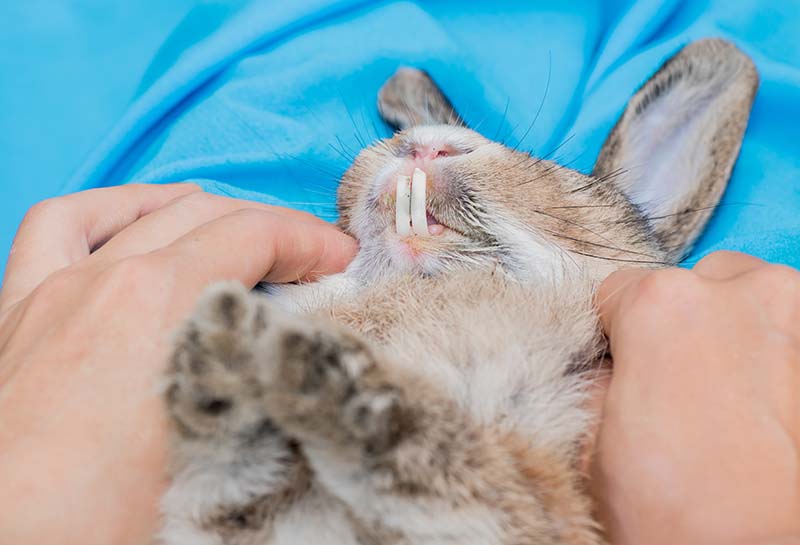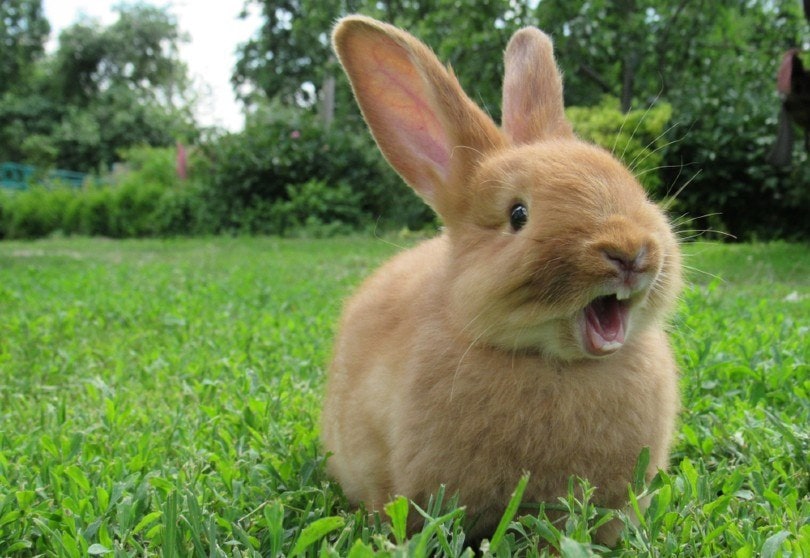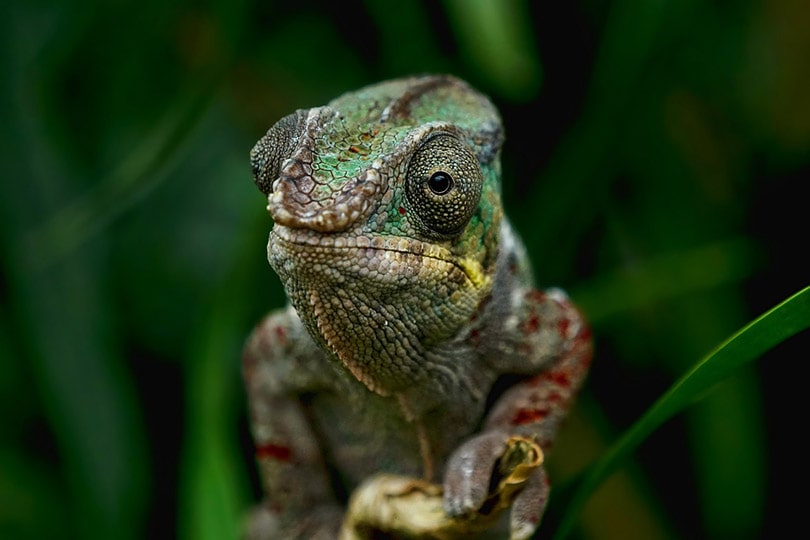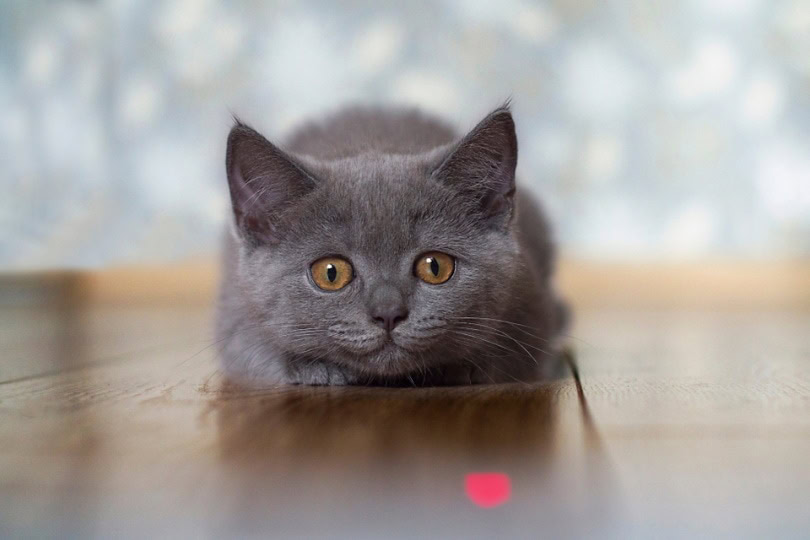VET APPROVED

The information is current and up-to-date in accordance with the latest veterinarian research.
Learn more »Click to Skip Ahead
Rabbits are known for their big ears and teeth. Despite the fact that they love to nibble, gnaw, and chew all day, their teeth never seem to wear down – why? Rabbits’ teeth are constantly growing so they are able to deal with the high-fiber diet they eat. They have teeth that are open-rooted, meaning that they continuously erupt and grow throughout the rabbit’s life.
Rabbits’ teeth are designed never to stop growing and must be constantly ground down. The incisors have a unique layout; they grind against each other when the rabbit consumes grass, hay, and other vegetation.

Rabbit Tooth Anatomy
Rabbits have four tooth types: two types of incisors, molars, and premolars. Incisors work together to clip and cut food and cheek teeth grind and chew the food.
Rabbits have four upper incisors, with a pair of peg teeth behind the primary incisors. These are two tiny incisors that act almost as a locking mechanism for the bottom ones. The bottom incisors slide up between the upper incisors and peg teeth, meaning the bottom and top incisors constantly grind against each other, keeping both sets sharp and at an appropriate length.
Rabbits also have molars that they use to chew food side to side. For example, if a rabbit eats hay, the incisors will cut it, and the molars chew it. Molars also grow constantly and are kept short and in shape by the grinding motion that rabbits use to chew their food.
How Much Do Rabbit’s Teeth Grow a Day?
A rabbit’s healthy teeth will generally wear down at a rate of approximately 3 millimeter (mm) per week. By comparison, a misaligned set of teeth can potentially grow as much as 1 mm a day.


Problems With Rabbits Teeth: Malocclusion
Because rabbits’ teeth never stop growing, they can have serious (and even fatal) dental problems when the teeth don’t meet together as they should. Malocclusion is the term used to describe teeth that don’t meet properly, either partially or fully. Malocclusion can affect the incisors, molars, or both and can present different problems depending on which teeth are affected. Acquired dental disease in rabbits is very common and it affects rabbits’ quality of life severely. It causes malocclusion among other health problems.
Misaligned Incisors
If a rabbit’s incisors are misaligned, they won’t wear down properly. Because they’re not being ground against each other as they should, the incisors will continue to grow, sometimes curving out, making it almost impossible for a rabbit to eat effectively. If left to grow, the teeth can pierce the tissue in the mouth and cause severe pain or become so overgrown that the rabbit cannot eat at all, leading to starvation.
Misaligned Molars
The molars and premolars are the cheek teeth. They are located at the back of the mouth and used for grinding and chewing food passed to them from the incisors. These teeth can also become misaligned, but instead of growing up into the mouth, they develop sharp spikes and growths called “spurs.”
These spurs cut into the mouth’s soft tissue each time the rabbit chews, as rabbits chew from side to side and up and down. This can be incredibly painful, leading to the rabbit refusing to eat. They can also grow down and cause bone problems in the jaw, sometimes leading to abscesses and infection.
What Causes Malocclusion?
There are a few reasons why a rabbit’s teeth may become misaligned, the most significant of which is a poor diet. Rabbits are designed to eat a lot of roughage that naturally wears their teeth down. Rabbits in the wild will chew all day on grass or similar fiber. Hay is usually given to pet rabbits to chew on, but they’re also fed rabbit pellets or mixes. Eating mainly pellets instead of hay and other fibrous foods often can lead to overgrowth and malocclusion.
Genetics may also have a part to play. For example, some breeds of rabbits, like Dwarf or Lop-Eared rabbits, have smaller heads and jaws than their natural ancestors, leading to overcrowding of the teeth in the mouth because there isn’t enough room for them. This leads to malocclusion and overgrowth of the teeth.


What Are the Signs of Malocclusion in Rabbits?
Because of the dangerous nature of malocclusion, you need to know the signs. Malocclusion can lead to rabbits not being able to eat. If a rabbit doesn’t eat, its digestive system will stop moving, which is a condition known as gut stasis. Gut stasis can be fatal in rabbits; if a rabbit’s guts don’t constantly move, it will die.
- Teeth growing at angles into the mouth or out of the mouth
- Teeth physically not lining up correctly
- Sores or abscesses inside the mouth
- Drooling
- Difficulty eating and weight loss
- Less poop is being produced
- Problems grooming
- Pawing at the mouth
How To Prevent Dental Disease in Rabbits
Because rabbits’ teeth are continuously growing, there are some things you can do to help manage this. Providing food that mimics their natural diet is essential. Rabbits need a high-fiber diet rich in roughage, with unlimited access to hay, such as timothy or meadow hay, being the most important factor. Chewing fibrous material helps wear down the teeth if they are properly aligned.
If a rabbit’s teeth are not properly aligned (a condition called malocclusion), they will require ongoing veterinary care. Overgrown teeth need to be trimmed, typically under anesthesia, using a dental burr. This may need to be done once a month, or a few times a year, depending on the individual case. Teeth should never be clipped as this can crack or fracture the teeth.

Summary
Rabbits have teeth that never stop growing. Their teeth have open roots which produce new tooth material that lengthens the existing teeth. For this reason, a proper diet is crucial to keeping them at the correct length and shape. The upper and lower teeth will grind each other down if positioned correctly, keeping them at a suitable size. If their diets don’t contain enough fiber and roughage, or the teeth don’t meet together properly, they can overgrow and become very problematic. Overgrown teeth that hinder eating can be fatal for rabbits.
Featured Image Credit: Victoria Paladiy, Shutterstock










